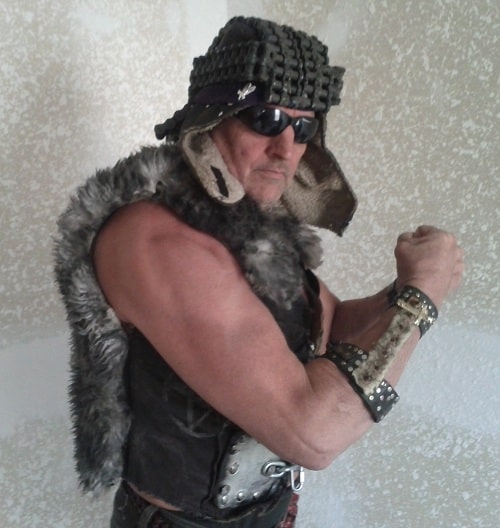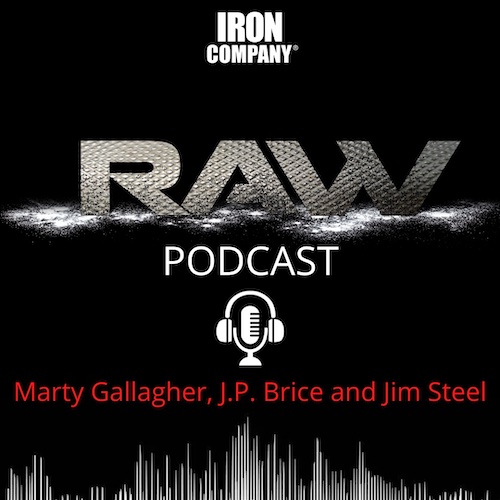
Steve Justa: the Paul Anderson of Sustained Strength
Meet the man that alerted us to the chink in our armor
Unlikely Avatar: all dressed up with nowhere to go, the godfather of sustained-strength at home on the farm getting ready for a walkabout with 800-pounds. He often smoked a cigar during his “strength-endurance” torture sessions.
Paul Anderson was the patron saint, the avatar of absolute strength. He roared out of the rural backwoods of the deep south and upended everything that preceded him. Anderson made his bones as an Olympic weightlifter, winning the gold medal at the 1956 Olympic games, less than five years after taking up the sport.
Until Anderson came along, Olympic weightlifters did the three lifts, press, snatch, clean and jerk, exclusively – want to get better at the press, snatch and clean and jerk? Do more presses, snatches and clean and jerks. Anything else was considered a superfluous waste of time. The uncontested athletic consensus of the time was that the “quick lifts” were so technical and precise that hours and hours of practice doing the three lifts (with ever increasing payloads) were the only training required.
Anderson came along and (to paraphrase) said “My technique sucks and will always suck. I think I can outlift everyone using bad technique. I am just going to get strong as hell and see if I can bull these weights overhead – technique be damned.” Yes, he practiced the Olympic lifts, but he spent more training time squatting, deadlifting, bench pressing, dumbbell pressing and barbell rowing. He drank two gallons of whole milk a day and pushed his bodyweight upward, sumo wrestler-like, until he reached 360-pounds.
Paul proceeded to start bulling-up world records. In 1956, Anderson set the world record in the overhead press, boosting it from 368 to 402 at Gorky Park in Moscow in front of 3,000 fans. Nikita Khrushchev (Soviet Premier and war hero) was a Big Paul fan and had Anderson come by for a private audience. The fawning Russian press dubbed Paul “the wonder of nature.”
Anderson inadvertently invented the modern absolute strength training template: core exercises done using a full range-of-motion for low reps; squat, bench press, deadlift, heavy rows, curls. Heavy eating was combined with compound multi-joint exercises, exercises that required groups of muscles to work together in muscular synchronization. These movements moved maximal poundage short distances and built maximum muscle. Anderson used this strategy to grow ungodly strong. He was on another strength planet, compared to his strength contemporaries.
Olympic weightlifting birthed the explosive strength training template, best exemplified by the whippet-lean lightning-fast Olympic weightlifter. Anderson birthed the absolute strength training template, exemplified by the muscled-up uber-strong powerlifter. We were still missing 33% of the optimal strength equation and didn’t even know it: while we identified and practiced absolute strength and explosive strength, no one practiced strength-endurance because no one had identified it as a missing component.
In 1998, the Paul Anderson of sustained strength emerged: an unlikely-looking dude with an incredible list of feats. Steve Justa exploded onto the strength scene. Randy Strossen, editor/owner of MILO magazine had the foresight and wisdom to read Steve’s manuscript and publish Justa’s 105-page book Rock, Iron, Steel, The Book of Strength. This was unprecedented in that Justa was nobody from nowhere; he had never won a national or world title in anything and did not inspire anyone with his physique.
He looked like a villainous professional wrestler, the overweight meatball that always losses. Steve lived on a farm in fly-over country, Harvard, Nebraska, and periodically smoked a cigar during his training. Yet Randy Strossen, as sophisticated a dude as has ever been associated with strength publishing, saw the brilliance in the manuscript Justa submitted. This was a strange book written by a strange man hailing from a strange place about a strange topic.
Justa’s rationale for writing the book was pointing out what he saw as a giant gap, a chink in the armor of strength athletes, an unaddressed weakness; he championed “strength-endurance,” sustained strength, a topic no one really thought about prior to 1998. Justa not only pointed out the need for strength-endurance he developed a system for infusing the body with locomotive-like sustained strength.
In the 1990s, the hardcore elite were diligently training absolute strength and explosive strength, no one trained sustained strength because no one thought about it. The need was not yet perceived. A strength-endurance philosophy did not yet exist, nor was there a strength-endurance Paul Anderson.
The concept of purposefully engaging in exercises and drills that demanded a sustained output of power and strength for extended periods was a totally foreign concept. At the time, any strength set that lasted passed 60-seconds was derisively labeled “aerobics.”
Purposefully training and taxing the cardiovascular system was associated with the Ken Cooper/Jane Fonda/Richard Simons brand of exercise, the effete dance aerobic class. Cardio was stigmatized as odious, noxious, feminized, and not suitable for uber-alpha strength athletes.
Steve Justa showed us a different flavor of cardio, a totally masculine approach. He would bear-hug a 225-pound cement block and walk with it for half a mile without setting it down, all the while smoking a cigar. This was MAN cardio.
Two dissimilar athletic events came into prominence in the 1990s that changed a lot of minds and opened a lot of eyes, each placed a supreme value on strength-endurance, i.e. being able to put out a high level of strength for extended periods: the first was strongman competitions and the second was the emergence of mixed martial arts.
Both absolute strength and explosive strength evolved because of their relationship with two sports: powerlifting and Olympic weightlifting. Strongman and MMA placed a premium on strength endurance.
Strongman events were tailored to cater to TV audiences and TV demanded the strongmen create longer events that would hold the viewer’s attention. To really determine the world’s strongest man, insofar as absolute strength or explosive strength, you would have competitors do a single rep in whatever event the promoter dreamed up. Making contestants struggle for 90-120 seconds to please TV audiences makes this, factually, a competition to determine the world’s strongest strength-endurance athlete.
A modern mixed-modern artist trains sustained-strength to near exclusion. MMA created a new breed of athlete, one that required “a bigger gas tank,” i.e. having an ability to not “gas out.” The goal is to be able to exert significant power deep into a 3 or 5 round fight, each round 5-minutes in length. When the modern MMA trainee loads up a wheelbarrow with barbell plates and pushes it up a hill, he is doing a Justa-style drill. Steve Justa pinpointed when he decided to become a strength-endurance disciple…
"I once saw a famous powerlifter perform eight reps with 505-pounds in the bench press. Thirty minutes later and he is still huffing and puffing as he’s talking to us on the microphone. I thought, ‘how much good is strength like that going to do you in a survival situation?”
Steve Justa was the Paul Anderson of sustained strength. His credentials lie in his feats, unrivaled and unreal, this is science fiction stuff – this man made an art form of struggle. Check out this partial crazed list of his incredible feats…
- Wearing a 200-pound chain-mail vest, walked for two miles in 50-minutes
- Created a 30-pound walking staff, walked 14-miles, never stopping or putting it down
- Created a 100-pound chain mail vest; wore it to work shoveling grain for weeks at a time
- Dragged a 540-pound railroad tie 1/8th of a mile in 25-minutes
- Picked the 540-pound railroad tie off the ground, shouldered it, walked for 30-feet
- Picked up and shoulder-carried a 315-pound barrel for 1/8th of a mile
- Pushed a 570-pound rock 1/8th of a mile in 25-minutes
- Carried a 220-pound rock for 1.5 miles in 90-minutes
- Picked up 500-pounds on a 2-inch thick handle barbell and walked 50-steps
- Carried a 250-pound barbell for a mile taking 18 breaks
- Carried a barbell loaded to 700-pounds for 20 steps backwards
My favorite Justa tale was when he created a 100-pound chain-mail vest and asked his boss if he could wear it to work and wear it while he worked. His job was a backbreaker: a worker in a grain silo pushing and shoveling grain all day long. His boss said, sure, as long as you don’t pass out and die. Justa wore it to work every day for a month.
Another crazed tale was when he purposefully walked with an 800-pound barbell on his back for 20 steps outside through mud ankle deep mud. Justa, hardly a fearful man, dubbed this his scariest feat. I laugh a bit when I see someone moan about the difficulty of handling “the beast” the famous 104-pound monster kettlebell. In 1995 Justa created a 300-pound kettlebell that he swung around like it was a 40-pound dumbbell.
Justa was a clear communicator. He spoke unvarnished plain-speak. His prose style was great and the message surprisingly sophisticated. He was quite comprehensive in his sustained-strength approach: he has created drills for carrying weight, dragging or pulling weight, he created G-force training and power aerobic isometrics, he had drills for running with weight and stresses periodic singles for strength. Steve explained the hand and thigh lift, the ¼ deadlift, the back lift, partial movements, the shovel lift, the pitchfork lift, and the barrel lift.
I would assume the book is still available at IronMind. If you are a serious strength trainer, shag a copy. This book is a great read and one of my top shelf classics.
About the Author - Marty Gallagher
As an athlete Marty Gallagher is a national and world champion in Olympic lifting and powerlifting. He was a world champion team coach in 1991 and coached Black's Gym to five national team titles. He's also coached some of the strongest men on the planet including Kirk Karwoski when he completed his world record 1,003 lb. squat. Today he teaches the US Secret Service and Tier 1 Spec Ops on how to maximize their strength in minimal time. As a writer since 1978 he’s written for Powerlifting USA, Milo, Flex Magazine, Muscle & Fitness, Prime Fitness, Washington Post, Dragon Door and now IRON COMPANY. He’s also the author of multiple books including Purposeful Primitive, Strong Medicine, Ed Coan’s book “Coan, The Man, the Myth, the Method" and numerous others. Read the Marty Gallagher Biography for a more in depth look at his credentials as an athlete, coach and writer.



